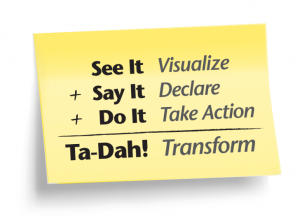 Calling All Parents and Teachers …
Calling All Parents and Teachers …
Welcome to the world of visualization—where children learn to learn better, achieve more and build confidence.
Children are naturally curious—think of all the things that a toddler and pre-schooler get into. What happens when the formal school years hit? Why do so many struggle in school, a place where their curiosity should be encouraged to grow?
For too many, the basic academic subjects—reading, writing, spelling and math—become frustrating. Your child may become a “behavioral” problem, stressed and/or anxious and a master of avoiding tasks.
No more.
With Dr. Lynn Hellerstein’s pioneering book, See It. Say It. Do It!®, your child will discover a whole new world. Action will be taken in all areas of his or her life by:
- Becoming more confident
- Creating strategies to overcome obstacles and barriers
- Being successful in school
- Developing a joy for learning
- Enhancing sports performance
Even if your child doesn’t have learning issues, See It. Say It. Do It!® offers the tools and strategies that will improve and empower performance levels.
Both you and your child will be celebrating with a huge Ta-Dah!
Buy See It. Say It. Do It! Today

How to Use This Book
This book is made up of four parts. Each section includes Activities to support its specific theme. The first part explores what visualization is and how it develops. In the second part, the See It. Say It. Do It! Model is introduced. The model was developed in my optometric practice. The acronym VDAT is the adult terminology for the See It. Say It. Do It! Model. It stands for Visualize, Declare, Take Action, and Transform.
Visualize is See It.
Declare is Say It.
Take Action is Do It!
The model leads to Transformation, which for your child is a huge Ta-Dah!
The third section includes specific visual processing skills and visualization strategies relating to school subjects that can help your child. Implementing them results in greater learning and confidence.
The final section provides a variety of topics that focus on personal growth, from getting along to dealing with scary and emotional situations.
A more thorough explanation of vision therapy as well as the results of our patient survey to evaluate effectiveness of their vision therapy is included in the Appendix. A glossary of vision terms and resources is also given.
Some of the chapters will have a numerical reference at the end of a sentence or paragraph. You will find details of a study or citing per the chapter in the Endnotes section at the back of the book.
I make suggestions on where these Activities can best be used throughout the book. Sometimes a road trip is a perfect place for one Activity; another might be at the dinner table, or just before a final bedtime goodnight. You’ll also find Dr. H’s Insight with each chapter—my “ahas” to you.
There are many books for adults on visualization, on business development, career goals, wealth development, meditative and spiritual growth. They are wonderful resources and I encourage you to use them for yourself if, after reading this book, you agree with me that visualization tools and practices can help on many levels and at any age.
I am surprised, however, that there aren’t more books for parents and teachers about visualization for children. Since kids are on such a rapid learning curve, introducing visualization skills early in life gives them an advantage in schooling and social skills.

